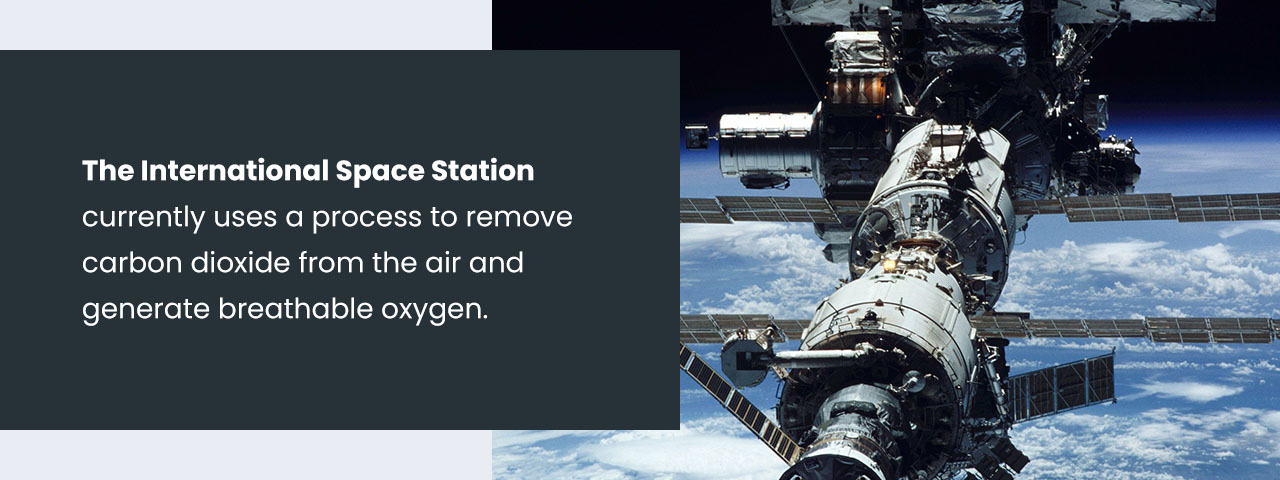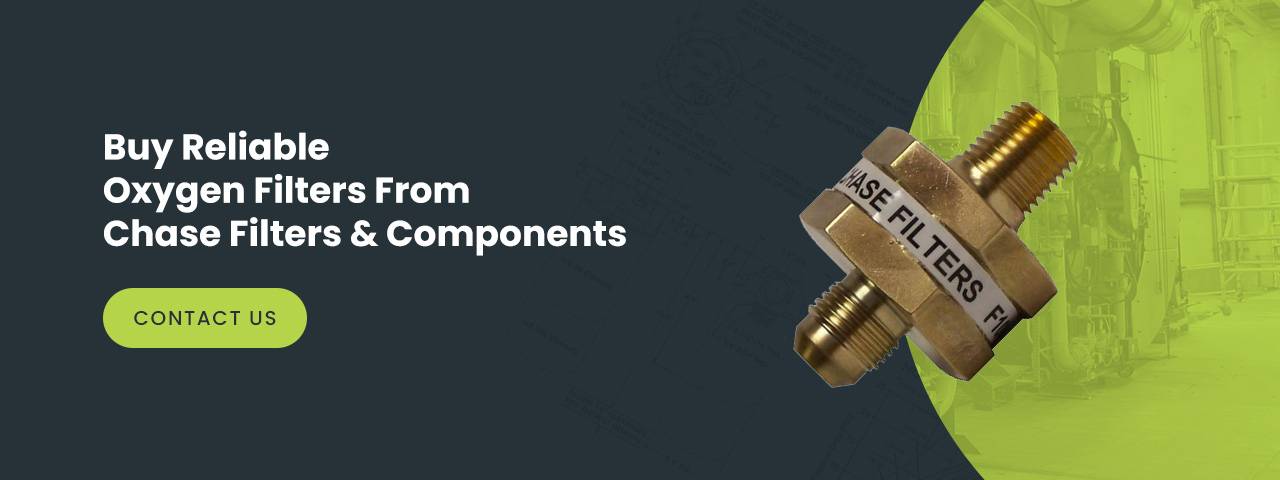October 2, 2025
The Complete Guide to Oxygen Filters

Jump To:
- What Is an Oxygen Filter?
- Where Are Oxygen Filters Used?
- Types of Oxygen Filters
- Applications of Oxygen Filters
- Functions of Oxygen Filters
- Benefits of Oxygen Filters
High-quality oxygen filtration is essential to ensure the delivery of reliable oxygen that follows air and gas purity standards. Besides filtering efficiently, oxygen filters also preserve the safety and integrity of your systems. Allowing damaging particulates to pass through your system unhindered can result in component malfunction. More importantly contamination can cause catastrophic events, like fire ignitions. Quality oxygen filtration provides you with dependable results for your end application and improves safety in your work environment.
An oxygen filter is an integral part of any air filtration or oxygen-reduction system. This guide to oxygen filters will help you learn more about these types of filters, their applications and their functions.
What Is an Oxygen Filter?
An oxygen filter works by trapping contaminants that enter or are generated within a system, keeping them from damaging vital components and otherwise tainting the health of your system. An oxygen filter is an essential element of an effective oxygen system.
Where Are Oxygen Filters Used?
One of the most prevalent uses of oxygen filters is in oxygen-reduction fire prevention systems. The National Fire Prevention Association (NFPA) states that three elements must be present in an environment for a fire to occur — combustible material, an ignition source and oxygen. The most common forms of fire safety, detection and extinguishing, are reactionary. Oxygen filters are only helpful at detecting fires that have already started.
These forms of fire safety have prevailed because it is virtually impossible to remove all three elements of potential fire hazard from an environment entirely. In many working conditions, removal of any of the elements is impossible.
The invention of oxygen-reduction fire prevention systems revolutionized fire safety. Oxygen-reduction technology can lower the oxygen level in the environment, keeping oxygen at a breathable level but precisely controlling it to reduce the risk of a fire. A higher concentration of oxygen threatens the following dangers:
- A more vigorous fire or combustion
- A lower ignition temperature, meaning easier fire ignition
- A higher flame temperature and destructive capability of a fire
Oxygen-reduction systems, which use oxygen filters, work preventatively to suppress a fire before it can ignite and damage lives and businesses.
Types of Oxygen Filters
Many oxygen filter designs work similarly by filtering damaging particulates or other particles out of an oxygen system to prevent premature component deterioration or malfunction. Wherever oxygen filters are used, they must be made of non-flammable materials.
Some manufacturers install inline oxygen filters, see the 20, the 25, or series within the piping footprint to catch rubber, metal, dirt and rust particles. These filters are ideal for areas with limited space and filter effectively even at higher operating temperatures and in corrosive environments.
A popular type of oxygen filter is the tee-type filter, see the 50 series oxygen filters which operate like an exhaust to trap particulates generated in gas and oil applications.
Applications of Oxygen Filters
Oxygen filter applications run the gamut from fire prevention to air purification for breathing. Many industrial applications require the consistent generation of high-purity oxygen at high concentrations. A higher level of oxygen means a higher risk of fire ignition, so the effective filtration of that oxygen is vital to the safety of manufacturers and the quality of production. Oxygen filters are helpful in the following applications:
- Aerospace: Proper filtration of oxygen is crucial on crewed space flights. The harsh conditions of space travel require astronauts to be able to produce oxygen from their surrounding air. The International Space Station currently uses a process to remove carbon dioxide from the air and generate breathable oxygen.
- Navy Seals: Special operations divers are in danger from toxic oxygen levels created at specific depths and pressures. Divers breathe through special oxygen filters that must regulate oxygen levels to prevent oxygen toxicity. Other applications within the military include breathing assistance for aviators and their ground support.
- Mining: There are strict limits on the amounts of silica dust safe to inhale. Prolonged exposure to the dust and gases created in mines can lead to serious health issues. Mines use oxygen filters to eliminate gases like carbon dioxide and methane and create a breathable atmosphere.
- Testing labs: The presence of multiple gases and chemicals in a testing laboratory creates the potential for ignition. An efficient oxygen filtration system can eliminate this danger.
- Air separation: Industries like manufacturing rely on air separation for production. The cryogenic air separation process extracts pure nitrogen and oxygen from the air, then filters the air of contaminants and carbon dioxide. The pure oxygen that results is highly flammable.
- Fume extraction: Filters used in fume extraction systems remove dangerous welding fumes from shop floors. In manufacturing and fabrication facilities, welding or cutting can create fires that spread quickly out of small areas. Installing a fume extraction system can mitigate the risk of fire.
- Laser-cutting: A high oxygen concentration ensures a high cutting speed and clean cut on the material. Steelmakers and manufacturers of other metals use this technique.
Functions of Oxygen Filters
Although oxygen filter applications are diverse, their functions are similar — all oxygen filters reduce contaminants within a system. Sometimes they function primarily as dirt filters to rid generated oxygen of particulates spoiling oxygen quality. In other applications, they separate air into its components, like oxygen, carbon dioxide and nitrogen. As a whole, oxygen filters keep systems clean and support the health of users.
Benefits of Oxygen Filters
One of the greatest benefits of oxygen filters is their fire prevention ability. The average atmospheric oxygen level is 21%, and oxygen-reduction lowers that level to 15%, which is proven to prevent fires. These hypoxic environments are carefully controlled and monitored to create clean-oxygen systems suitable for breathing.
Oxygen filters help with oxygen reduction, which is a chemical-free way to prevent fires. In an oxygen-reduction fire prevention system, filters use the air already present to produce breathable, non-flammable air. This process prevents other chemicals from entering the system and is a continuous way to avoid fire. The straightforward installation and maintenance of oxygen filters make them a low-maintenance option for filtration. They generally take up little space and can be used in existing premises.
Oxygen filters slow oxidation and the buildup of contaminants, thereby reducing deterioration of equipment and machinery. When combined with other fire detection and prevention systems, oxygen filters are used to enhance fire safety.
Buy Reliable Oxygen Filters From Chase Filters & Components
The innovative design of ignition-resistant oxygen filters makes them an excellent choice for filtration and fire prevention. Chase Filters & Components engineers and produces oxygen filters to serve a wide array of industries.
We provide you with the highest-quality filters, so you can trust us for your critical operations. We make the Chase 20, 25, 30 and 50 Series oxygen filters of high-quality, ignition-resistant brass or Monel, granting peace of mind in your filtration applications.
Browse our selection of high-pressure oxygen filters online. For assistance with even the most advanced filtration applications, contact our skilled team today.

